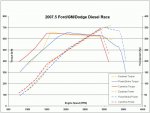Travis,
Thanks for all of the helpful information. My RPM's and MPH's are what they are, what can I say...stranger things have happened. ...
let us know what you find after you swap tachs around. did you see what model trans you have? the tag is on the side of the case.
... I hope you will share your experience and opinion on power steering ( or assist ) for the deuce as well. I need to get on that before I lose a thumb. ...
you have 16.00's and no power steering? oh my.... your arms must be larger than Magnus von Magnusson's.

that'd be something pretty high on my list of things to do. i did the PSC full-hydro kit and love it, but my rig was built for offroad. it drives the highway great, i just wanted the simplicity of hydro. do the search and there are fantastic threads about adding hydro-powered steering gear boxes that are basically bolt-on. i was afraid of bump-steer or binding when combined w/ the lift springs, but don't know if this is an actual concern or not.
... So, turn up the fuel. Doesn't that make the turbo spool up quicker ( at a lower RPM ) ? Wouldn't making more power at a lower RPM be lowering the power band ? I'd sure be willing to try it. ...
not neccissarily - low rpm fueling is controled by the fuel stop in the injector pump. this adjustment will have more of an effect on turbo spool than the max fuel rate will, unless we get into swapping on a very large turbo (which is another, lengthier, discussion). once under load, however, more fuel will produce more drive pressure which will produce higher boost levels. i went from a maximum of ~8psi to 12+ psi after i turned up the fuel, but i didn't notice a faster turbo spool rate at lower rpms, just that it would spool to higher levels.
... I thought "under the curve" is camshaft terminology. In reference to how well they breath. A cam that has a steeper ramp ( like a roller ) breathes more in the same amount of duration than a flat tappet. That extra breathing area is called " area under the curve"
i was referencing a power band graph or curve, and the associated "area under that curve." what i was mentioning was that having more gears is a good practice to access better power out of engines that have a very steep or 'peaky' power curve.
take a look at this
wiki article - while not the best write-up ever, it does a decent job at explaining differences in power band characteristics. it also mentions how wider/flatter power bands allow the use of fewer transmission gears whereas peakier bands will require tighter gear ratios in order to keep the engine performing well.
in my opinion, the power band is actually fairly flat on the MF engine - this is because of the injector pump fueling rates and govenor set up and because the overall power output is very very low. and my point is that a relatively flat power curve does not benefit greatly with the addition of more gears.
so, because the curve is so low and relatively flat, i would suggest that the MF would benefit from increasing the power before it would benefit from more gears. both would be best, but the better bang-for-buck would fall on the fuel increase.
compare the attached late model light duty diesel power curves to the
6.4 medium duty application power curves - same motor, but different tuning for different applications. in the light duty trucks, you'll see broader torque and hp curves with extended rpm ranges for good, well-rounded driving. in a medium or heavy duty curve, they'll be sharp angles and steep peaks with limited rpm ranges which is why they use transmissions with more gears. example: on the chart you'll see the Ford make over 600ft-lbs for over a 1400 rpm span, and from the International link you'll see over 600ft-lbs from as little as a 400 rpm span. you could drive the Ford comfortably from 1500-3500rpm whereas you could only drive the Int'l from 1300-2700 rpm.




